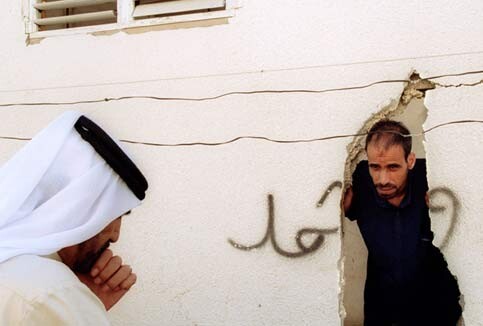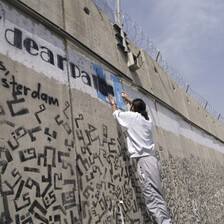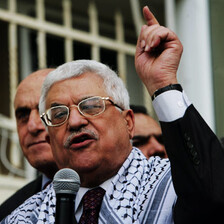The Electronic Intifada 30 December 2003

Rafah, occupied Gaza, July 2002. The border between the Gaza Strip and Egypt goes right through a city called Rafah. Since the first Intifada, Israeli tanks regularly drive along the border in the middle of the night and shoot randomly at the surrounding houses. Sometimes it is just shooting and sometimes without warning bulldozers come to destroy some houses ‘for security reasons’. The fathers in the area near the border stay up every night untill 4:30AM in case the tanks come to their street and they have to quickly evacuate their family. The children mostly don’t sleep well because of the shooting. Many children have symptoms of stress. Pictured above, Mr. Soufi in his house. Israeli tanks had visited his street the previous night. (Johannes Abeling)
The year 2003 started and ended with Israeli forces invading Rafah refugee camp and demolishing refugee homes. On January 2, Israeli forces demolished 25 homes, leaving 85 Palestinian families homeless. Refugees were forced to leave their homes at one o’clock as Israeli bulldozers smashed their property. This week, just days before Christmas, Israeli forces, reinforced by tanks and attack helicopters attacked the densely populated area again. Refugees came under intense shelling and indiscriminate shooting and homes were demolished. In three years, Israeli forces have demolished 800 homes in Rafah alone.
In 2003, Israeli forces attacked Rafah and its vulnerable residents on a daily basis. Larger military operations against Rafah’s residents took place in January, April, May, September, October, November and December. In all these operations, Israeli forces, using heavy arms and equipment, killed or wounded civilians, demolished homes and terrorised Rafah’s residents.
Rafah is located in the southern part of the Gaza Strip, at the border with Egypt. Rafah refugee camp was established in 1949 to provide shelter to 41,000 refugees. It was the largest and most densely populated refugee camps in the Gaza Strip. The camp is divided into 17 blocks.
On March 16, Rachel Corrie, a 23-year-old American peace activist, was crushed to death by an Israeli army bulldozer. She was killed, trying to protect the home of a Palestinian doctor, his wife and three children. Less than one month later, Tom Hurndall, a young photographer, was shot in the head by the Israeli army in Rafah. He currently lies in a vegetative state at the Royal Hospital for Neurodisability in Putney after suffering severe brain damage from which he is not expected to recover. On May 2, James Miller, an award-winning British TV cameraman, who was making a documentary about Palestinian children in Rafah, was shot dead by the Israeli army.
What didn’t happen in 2003 is that no Israeli soldier or officer has been charged with misconduct. The Israeli government has called Rachel Corrie’s death an accident but has refused to release the military report clearing the bulldozer operator. Israel has also denied that its military shot Tom Hurndall with intent. Only in October, the Israeli military Attorney General, Menachem Finkelstein, agreed to open a military investigation into Tom’s shooting.
The family of James Miller has been told that the report into his death has been delayed yet again. After Britain’s Foreign Secretary Jack Straw announced that the bullet which killed James Miller was fired by an Israeli soldier, Israeli Prime Minister Ariel Sharon assured Straw that a full and transparent investigation would be carried out. However, to date no report has been completed.
In Rafah alone, Israeli forces killed this year at least 60 Palestinians. Among them Ali Ghuraiz (8), Sami Zo’rob (50), Ahmad Abu Elwan (13), Aziza al-Qassir (50), Mohammed Hamaida (14), Ahmad al-Najjar (45), Wissam al-Sha’er (24), Walid Liddawi (19), Ibrahim Abu Shallouf (18), Abed Abu al-Sa’id (14), Mohammed Hamdan (16), Ibrahim Qrainawi (8), Sami Salah (15) and Mahmoud Abu Koush (15). Who asks Israel to explain?
Rafah in 2003 is an example of occupied Palestine in 2003. Death and injury by indiscriminate and excessive use of force are not the excemption. Rafah is not immune to Israel’s policy of assassination and destruction, detention and torture, restrictions on movement or any other violations of human rights.
While the world’s road map and the Geneva Accord already proved mere ink on paper and are considered by many a dead letter, refugees in Rafah are concerned about their existence, their lives, their children and their future. Despite road maps and declarations, the residents of Rafah are in urgent need of protection. They need peace and justice. They want to stop counting the deaths.
Related Links:





